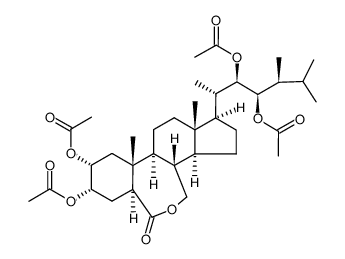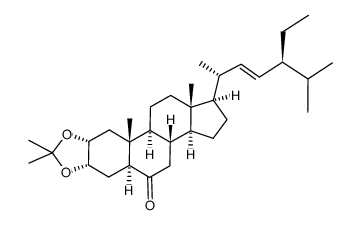72962-43-7
| Name | brassinolide |
|---|---|
| Synonyms |
2α,3α,22,23-tetrahydroxy-24-methyl-B-homo-7-oxa-5α-cholestan-6-one
cis,cis-1,6-Dioxa-3,8-cyclodecadien 1,6-dioxa-cyclodeca-3,8-diene (3aS,5S,6R,7aR,7bS,9aS,10R,12aS,12bS)-10-[(2S,3R,4R,5S)-3,4-Dihydroxy-5,6-dimethyl-2-heptanyl]-5,6-dihydroxy-7a,9a-dimethylhexadecahydro-3H-benzo[c]indeno[5,4-e]oxepin-3-one (3aS,5S,6R,7aR,7bS,9aS,10R,12aS,12bS)-10-[(2S,3R,4R,5S)-3,4-Dihydroxy-5,6-dimethylheptan-2-yl]-5,6-dihydroxy-7a,9a-dimethylhexadecahydro-3H-benzo[c]indeno[5,4-e]oxepin-3-on (2α,3α,5α,22R,23R,24S)-2,3,22,23-Tetrahydroxy-B-homo-7-oxaergostan-6-one 2a,3a,22,23-Tetrahydroxy-24-methyl-B-homo-7-oxa-5a-cholestan-6-one (3aS,5S,6R,7aR,7bS,9aS,10R,12aS,12bS)-10-[(1S,2R,3R,4S)-2,3-dihydroxy-1,4,5-trimethylhexyl]hexadecahydro-5,6-dihydroxy-7a,9a-dimethyl-3H-benzo[c]indeno[5,4-e]oxepin-3-one 3H-Benz[c]indeno[5,4-e]oxepin-3-one, 10-[(1S,2R,3R,4S)-2,3-dihydroxy-1,4,5-trimethylhexyl]hexadecahydro-5,6-dihydroxy-7a,9a-dimethyl-, (3aS,5S,6R,7aR,7bS,9aS,10R,12aS,12bS)- 1,6-Dioxacyclodeca-3,8-dien 3H-Benz[c]indeno[5,4-e]oxepin-3-one, 10-[(1S,2R,3R,4R)-2,3-dihydroxy-1,4,5-trimethylhexyl]hexadecahydro-5,6-dihydroxy-7a,9a-dimethyl-, (3aS,5S,6R,7aR,7bS,9aS,10R,12aS,12bS)- (1R,3aS,3bS,6aS,8S,9R,10aR,10bS,12aS)-1-[(1S,2R,3R,4S)-2,3-dihydroxy-1,4,5-trimethylhexyl]hexadecahydro-8,9-dihydroxy-10a,12a-dimethyl-6H-benz[c]indeno[5,4-e]oxepin-6-one (3aS,5S,6R,7aR,7bS,9aS,10R,12aS,12bS)-10-[(2S,3R,4R,5R)-3,4-Dihydroxy-5,6-dimethyl-2-heptanyl]-5,6-dihydroxy-7a,9a-dimethylhexadecahydro-3H-benzo[c]indeno[5,4-e]oxepin-3-one (2a,3a,5a,22R,23R,24S)-2,3,22,23-Tetrahydroxy-B-homo-7-oxaergostan-6-one Brassinolide (3aS,5S,6R,7aR,7bS,9aS,10R,12aS,12bS)-10-[(2S,3R,4R,5S)-3,4-Dihydroxy-5,6-dimethylheptan-2-yl]-5,6-dihydroxy-7a,9a-dimethylhexadecahydro-3H-benzo[c]indeno[5,4-e]oxepin-3-one brassinosteroid MFCD00133310 |
| Description | Brassinolide is a predominant plant growth modulator that regulate plant cell elongation. |
|---|---|
| Related Catalog | |
| Target |
plant growth modulator[1] |
| In Vitro | Brassinolide is a plant sterol first isolated from pollen of rape (Brassica napus L.). Brassinolide can induce a time and concentration-dependent cytotoxicity in PC-3 cells. The mode of cell death appears to be predominately apoptosis, as shown by flow-cytometric analysis, fluorescence and transmission electron microscopes. Caspase-3 activity is obviously increased after Brassinolide treatment. Western blot studies indicate that treatment with Brassinolide triggered a time-dependent decrease in the expression of anti-apoptotic protein Bcl-2, which suggests that Brassinolide can induce cytotoxicity in PC-3 cells by triggering apoptosis. Brassinolide might therefore be a promising candidate for the treatment of prostate cancer[1]. Brassinolide is a plant growth modulator, on multidrug resistance (MDR) of human T lymphoblastoid cell line CCRF-VCR 1000 which is obtained by progressively addition of vincristine (VCR) to sensitive CCRF-CEM cells, and to explore preliminarily the mechanism of reversing action. After treatment of Brassinolide under the concentration of 0.001-10 μg/mL, the resistance of CCRF-VCR is reversed partly with the reversing folds respectively as 4.4-11.6. The intracellular accumulation of rhodamine 123 is significantly reduced in the resistant cells. After treatment of Brassinolide, the accumulation increased, the level of fluorescent dye is situated between resistant cells and sensitive cells. No alteration of the catalytic activity of topoisomerase II is found among three groups. The level of protein expression of p53 in resistant cells is higher than that of sensitive cells. After Brassinolide treatment, the expression of p53 in CCRF-VCR cells restored to the level of sensitive cells. Brassinolide can effectively reverse the resistance of CCRF-VCR cells by inhibiting the effusion of drug transported by P-glucoprotein. To down regulate the abnormal expression of p53 maybe one of the mechanisms of reversing MDR for Brassinolide[2]. |
| Cell Assay | MTT method is used to detect the resistant factor of resistant cell line and the reversing fold after addition of Brassinolide. The intracellular accumulation of rhodamine 123, a fluorescent dye transported by P-glycoprotein is detected by flow cytometry, the catalytic activity of topoisomerase II is assessed by Sulliven method to find the effect of Brassinolide on resistance. The protein expression of p53 is measured using Western blotting in the sensitive cells and resistant cells to explore the effect of Brassinolide[2]. |
| References |
| Density | 1.1±0.1 g/cm3 |
|---|---|
| Boiling Point | 633.7±55.0 °C at 760 mmHg |
| Melting Point | 200-204ºC |
| Molecular Formula | C28H48O6 |
| Molecular Weight | 480.677 |
| Flash Point | 202.3±25.0 °C |
| Exact Mass | 480.345093 |
| PSA | 107.22000 |
| LogP | 3.12 |
| Vapour Pressure | 0.0±4.2 mmHg at 25°C |
| Index of Refraction | 1.536 |
| Storage condition | −20°C |
| Hazard Codes | T+ |
|---|---|
| WGK Germany | 3 |
| Precursor 9 | |
|---|---|
| DownStream 0 | |



![(2R,3S,5S,8S,9S,10R,13S,14S,17R)-17-((S)-1-((4R,5R)-2,2-dimethyl-5-((S)-3-methylbutan-2-yl)-1,3-dioxolan-4-yl)ethyl)-2,3-dihydroxy-10,13-dimethylhexadecahydro-6H-cyclopenta[a]phenanthren-6-one structure](https://image.chemsrc.com/caspic/488/83066-72-2.png)

![(3S,8S,9S,10R,13S,14S,17R)-17-((S)-1-((4R,5R)-2,2-dimethyl-5-((S)-3-methylbutan-2-yl)-1,3-dioxolan-4-yl)ethyl)-10,13-dimethyl-2,3,4,7,8,9,10,11,12,13,14,15,16,17-tetradecahydro-1H-cyclopenta[a]phenanthren-3-ol structure](https://image.chemsrc.com/caspic/005/83066-67-5.png)

![(3S,8S,9S,10R,13S,14S,17R)-17-((S)-1-((4R,5R)-2,2-dimethyl-5-((S)-3-methylbutan-2-yl)-1,3-dioxolan-4-yl)ethyl)-10,13-dimethyl-2,3,4,7,8,9,10,11,12,13,14,15,16,17-tetradecahydro-1H-cyclopenta[a]phenanthren-3-yl 4-methylbenzenesulfonate structure](https://image.chemsrc.com/caspic/090/75608-33-2.png)
![(3S,5S,6S,8S,9S,10R,13S,14S,17R)-17-((S)-1-((4R,5R)-2,2-dimethyl-5-((S)-3-methylbutan-2-yl)-1,3-dioxolan-4-yl)ethyl)-6-hydroxy-10,13-dimethylhexadecahydro-1H-cyclopenta[a]phenanthren-3-yl 4-methylbenzenesulfonate structure](https://image.chemsrc.com/caspic/069/75608-29-6.png)


